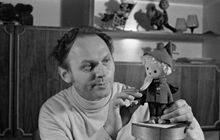|
Sandmännchen
  Unser Sandmännchen ("Our Little Sandman"), Das Sandmännchen ("The Little Sandman"), Der Abendgruß ("The Evening-Greeting"), Abendgruß ("Evening-Greeting"), Der Sandmann ("The Sandman"), Sandmann ("Sandman"), Sandmännchen ("Little Sandman") is a German children's bedtime television program using stop-motion animation. The puppet was based on the Ole Lukøje character by Hans Christian Andersen. Two versions of Sandmännchen were created: one in East Germany (Unser Sandmännchen), and one in West Germany (Das Sandmännchen). The series is the longest-running animated television series in history; additionally, it is the TV show with the most episodes in history. Background The original idea came from Ilse Obrig, who in 1950 changed from East Berlin's Berliner Rundfunk (BERU) to West Berlin TV and radio station Sender Freies Berlin (SFB). With the help of author Johanna Schüppel, she developed a working version of the character and its story in 1958. The Little Sandman himself first appeared on screen in West Berlin in Sandmännchens Gruß für Kinder (Sandmännchen's Greeting to Children) on 1 December 1959, and other episodes were soon made. However, already on 22 November 1959 (only three weeks after the production had started), East German television Deutscher Fernsehfunk (DFF) began broadcasting its own Unser Sandmännchen, complete with its own "good night, children" character, also called Sandmännchen. Created by the puppetmaster and director Gerhard Behrendt, the East German show represented everyday life, travel, and fantastic adventures. The character often showcased socialist technological achievements, such as the use of awe-inspiring vehicles like futuristic cars and flying devices. It was very popular with GDR citizens to the point that after the wall fell, former citizens lamented the appropriation of the beloved cartoon by corporate West German television. The production of the West German version of Sandmännchen ceased in 1991, following the unification of Germany. The East German version was ultimately more popular, and repeats of episodes are still broadcast today. A full-length feature film, The Sandman and the Lost Sand of Dreams (German: Das Sandmännchen – Abenteuer im Traumland, literally "The Little Sandman – Adventure[s] in Dreamland"), was released in 2010.  Theme tuneWolfgang Richter composed the theme to the East German programme in just three hours one evening. Wolfgang Krumbach wrote the text. It was sung by the Rundfunk-Kinderchor Berlin.[2][3] Opening verse (on the Sandman's arrival):
Translation:
There was a second verse which was dropped after the German reunification because it mentions the East German Fernsehfunk which no longer existed:
Translation:
Closing verse (when he leaves):
Translation:
The score and overall design of the show was remarkably elaborate for a children's television production. The Sandman often visited other countries, and this fact was frequently emphasised by the use of traditional instrumentation and harmony added to the score. International broadcastsThe East German show was shown in many countries, including western countries like Finland, Sweden, Denmark and Norway. The show was named "Jon Blund" in Norway, "John Blund" in Sweden and "Nukkumatti" in Finland. The theme song in Norway went as follows:
In English, this means:
The first verse of the theme song in Swedish was:
In English, this means:
The theme song in Finland was:
In English, this means:
Supporting charactersThe Sandmännchen stories contained a number of characters who remain popular today:
In popular cultureEven after German unification merged the former German Democratic Republic into the Federal Republic of Germany, the Sandmännchen has retained a following, and it continues to be shown every night on German television. Periodic references have been made to it in film and literature.
See alsoReferences
External linksWikimedia Commons has media related to Sandmännchen.
|
||||||||||||||||||||||||||||||||||
